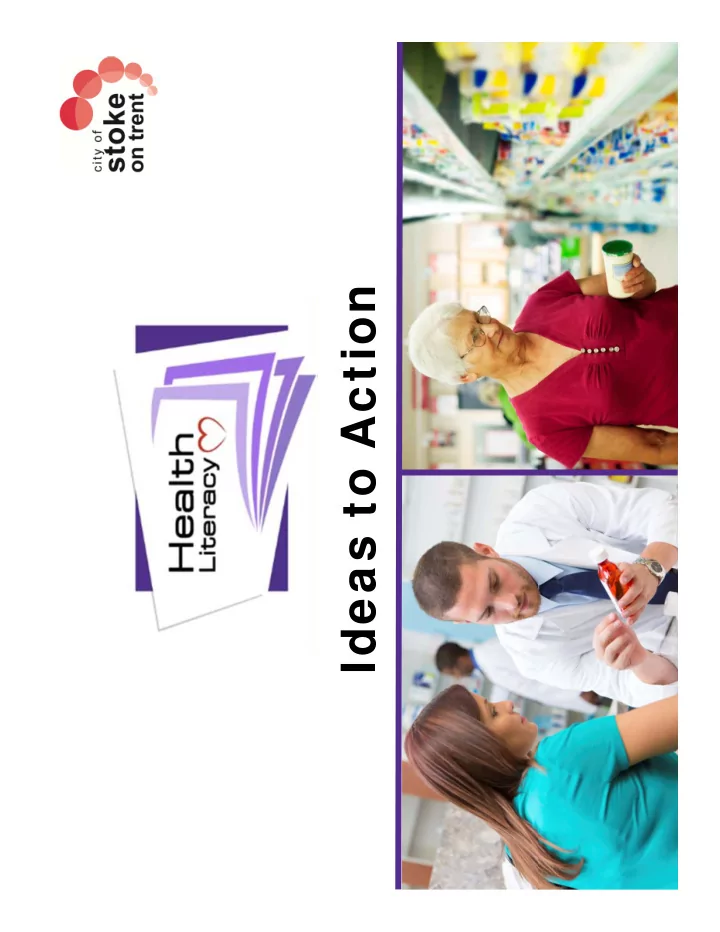

Ideas to Action
Agenda 5:30 – Arrive, eat and meet 6:00 – Welcome and how the evening will run – Mike Oliver and Judy Kurth 6:10 – Health Literacy : stories from the frontline – Jo Protheroe and Jonathan Berry 6:55 – Action planning by priority theme – table activity 7:40 – Feedback from each table 7:50 – Personal action pledges – table activity 8:00 – Feedback from each table 8:10 – Close, thank you and next steps
Judy Kurth
Health Literacy in Stoke The journey so far – thank you for your input and support A better understanding of what HL in action in Stoke- on-Trent could mean A local study - leaflets in pharmacies in the city – Jo and Emee Community Health and Learning Foundation - Jonathan
Health Literacy in Stoke A ‘framework’ in which to actually start delivering Adult Literacy bid Budget and resources
Health Literacy in Stoke What happens after tonight? Ideas into action We are here to help
Health Literacy in Stoke Our new leaflet
Jonathan Berry Jo Protheroe &
Community Health & Learning Foundation Ideas to Action Stoke-on-Trent March 2015
Who Are We? UK’s leading Health Literacy organisation fundamental purpose is to support the creation of Health Literate Health and Social Care system and reduction of health inequalities
AIMS To raise practitioners’ awareness about Health Literacy To improve people’s Health Literacy To raise policy makers’ awareness of Health Literacy To enable people with low Health Literacy to shape health information To inform policy UK wide To raise general awareness about what Health Literacy means To highlight the contribution that learning can make to health improvement
Literacy: What Does It Mean? Below Level 1 – can’t find relevant information in leaflets (approx 5m) Below Entry 3 – can’t explain straightforward feelings/symptons over the phone (approx 1.7m) Below Entry 2 – can’t follow a simple letter from the surgery (approx 1m) Skilled for Health: Making the Case (2006) Berry, J et al
Numeracy What Does It Mean? Below Level 1 – can’t work out mean (average) calorie intake (approx 14m) Below Entry 3 – measure and record height and weight on a chart (approx 6.5m) Below Entry 2 – work out how many tablets to take in a week (approx 1.5m) Skilled for Health: Making the Case (2006) Berry, J et al
What Does it Feel Like? Listening and Writing Numbers Pictures
The story of Jimmy! From Dr Suzanne McCarthy and Dr Laura Sahm, University of Cork “Take one tablet on Monday, one tablet on Tuesday, and skip Wednesday” Monday Wednesday Tuesday 1 in 5 Irish people are not confident that they understand all the information which their health professional gives to them 1 in 10 people admitted to taking the wrong dose of medication 43% would only sometimes ask for because they didn’t understand the instructions given. information to be explained more clearly
Case Studies/Focus Groups Words of multiple meaning problematic Complex words hard to understand Symptoms – very confusing Medical words – not well understood Some diagrams caused confusion/provoked more questions eg arms
Case Studies/Focus Groups Positive Waist? Cervix? Collarbone Prostate 5 a day
Health Literacy cuts across key domains Patient Activation - E.g. informed consent, shared decision making Public Health/Health Inequalities - E.g. healthy eating, physical activity messages Treatment and Adherence - E.g. how to explain symptoms and risks, self care, taking medication PPI - E.g. responding to service reconfiguration
What can we do about it? Think of examples of when you may have 1. encountered or have had to take into account low Health Literacy issues within your role. What impact does low Health Literacy have on 2. your area of responsibility? What do you need to do to make sure that 3. people and communities with low Health Literacy are considered within your area of responsibility? What is your role in that? 4. Who else could help? 5.
What Makes a Health Literate Service? What Does It Look Like? What is Success?
Resources SMOG – Simple Measure of Gobbledygook TOFHLA – Test of Functional Health Literacy in Adults REALM – Rapid Estimate of Adult Literacy in Medicine NVS - Newest Vital Signs SfH – National Health Literacy Course
Skilled for Health Skilled Skills for Life Health and for (Language, Literacy Health w ellbeing and Numeracy)
Health Literacy – key publications Health Literacy: the agenda we cannot afford to ignore, CHLF (2014) Skills for Life Survey, BIS (2011) The Marmot Review – Strategic Review of Health Inequalities in England post 2010 (2010) The cost of limited health literacy: a systematic review : K.Eichler, S.Weisser, U.Brugger (2009) The evolving concept of health literacy : Don Nutbeam (2008) Useful websites: www.healthliteracy.org.uk and www.chlfoundation.org.uk
Any questions?
For more information… Community Health and Learning Foundation www.chlfoundation.org.uk Jonathan Berry - Director 07525 347269 Jonathan.berry@chlfoundation.org.uk
Over to you Actions stoke.gov.uk
Personal pledges Over to you stoke.gov.uk
Thank you for taking part
Recommend
More recommend